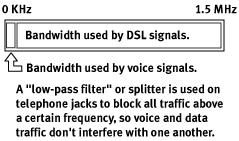What is DSL?
 DSL, or Digital Subscriber Line, uses the available bandwidth in your phone line to deliver additional signals. A typical pair of copper wires in your phone is capable of carrying information on many different frequencies.
DSL, or Digital Subscriber Line, uses the available bandwidth in your phone line to deliver additional signals. A typical pair of copper wires in your phone is capable of carrying information on many different frequencies.
Your phone line has a wide range of frequencies available, and in order to use DSL, you must ensure that the DSL signals and your telephone conversations do not interfere with one another. Several low channels are used for voice signals, and the remaining channels are used for DSL signals. In some cases, a "buffer" of frequencies is intentionally left unused between the voice and DSL frequencies.
To prevent your voice conversations from interfering with each other, "low-pass filters" or "splitters" must be used on all voice jacks. These devices block out all signals above a certain frequency, so your voice and data transmissions do not use the same frequencies. You do NOT use a filter on the jack that plugs into the DSL modem.
DSL signals can be "asymmetric " (ADSL), meaning the upstream and downstream capabilities are not equal. The companies providing the signal assume that you will have more download traffic than upload traffic, and they partition your bandwidth accordingly. Symmetric (SDSL) offers the same speed capabilities for both upload and download traffic. Unlike cable Internet access, a DSL line is a dedicated resource, not a shared one. That means that if everyone on your street has DSL and everyone uses it at the same time, no one will lose bandwidth.
In the United States, DSL speeds are currently limited to 1.5 Mbps, though technically the technology is capable of 7 Mbps throughput. The next generation, VDSL (very high bit rate DSL), will be capable of delivering up to 52 Mbps, enough to support a new generation of video and audio content delivered on demand. At these speeds, you could easily download a DVD-quality movie and watch it in real time.
Are there limitations to DSL service?
A significant drawback of DSL is that you must live within approximately three miles of the Central Office (CO) that serves your address. The strength of the signal degrades over distance, and unlike regular telephone signals, you can't boost the signal strength along the way. Your distance from the CO also affects your connection speed: the closer you live to the CO, the faster your connection. DSL providers usually post the best possible speeds (for example, 1.5 Mbps download/1 Mbps upload). Unless you live very close to the CO, you will not get these speeds. You must have a "clean copper pair" available between your house and the CO. A clean copper pair is a set of wires that is used exclusively for the purpose of transmitting your signal and your signal only. When used to aggregate telephone signals together, a copper pair is no longer considered "clean."
How do I get DSL?
www.dslreports.com is a good place to start. It provides impartial reviews and prices for most DSL providers in the United States. By entering your phone number and street address, the site will determine which companies provide service for your location, and will list their fees, installation charges, equipment fees, and other expenses.
 What is Satellite Internet Access?
What is Satellite Internet Access?